Table of content
About Great Nicobar
The islands are densely forested with coconut and betel-nut palms and pandanus, mango, margosa, and beefwood (Casuarina) trees. The population consists mostly of two ethnic groups, the Nicobarese and the Shompens. Agriculture is the principal occupation; crops include rice, corn (maize), fruits, vegetables, coconuts, and betel nuts. Copra (dried coconut) making and oil pressing are the chief industries. The only major town is on Car Nicobar.
Yes, You Can Visit A Nicobar Island!


Is Great Nicobar “The Nicobar”?
Located at the extreme southernmost end of the Indian territory, Great Nicobar is the very last island of the Andaman and Nicobar Archipelago. The Nicobar Group of Islands consist of 22 islands which are divided into northern, middle and southern sub groups. Great Nicobar belongs to the southern group and this is where the famous tourist location of Nicobar, Campbell Bay is located. Great Nicobar Islandis the largest of the Nicobar Group of Islands, spanning 921 km, and is home to about 9000 people.
Unlike islands in Northern Nicobar such as Car Nicobar and Battimalv, which are flat with rich, fertile soils, Great Nicobar in Southern Nicobar is comparatively hilly. A large portion of the island is covered in dense forests which are home to a variety of endemic biodiversity including the Nicobar Megapode, the Nicobar Tree Shrew, and the Nicobar Long-tailed Macaque. The most common visitors to the island are naturalists, birders, and researchers as the Geography of Andaman and Nicobar islands is very rich. The highest peak of Nicobar Islands is Mount Thullier, at 2,106 feet (642 metres), situated in Great NicobarIslands.
This huge island is slow-paced, and is home to a close-knit community of individuals who have made their living there over several generations. The working population majorly run small grocery shops, eateries, service centers, or own coconut and betel nut plantations. Apart from this, a significant number of government employees are present here. These individuals are stationed at the Naval, Coast Guard, and Army regiments. Other government employees include those working for the BSNL Telecom Service, the Post Office, and the State Transport Service.


Highlights – Great Nicobar
- Permissions
Indian citizens do not require prior permission to visit the island of Great Nicobar. Foreign nationals need to visit the Assistant Commissioner’s office in Port Blair before making their travel reservations.
After arriving at Great Nicobar, tourists need to meet officials from the Forest Department in Campbell Bay to arrange visits to Biosphere Reserve and Galathea National Park.
- Great Nicobar Biosphere Reserve and Galathea National Park
For naturalists and birders alike, both of these places hold great significance in terms of the species of trees, animals, reptiles, amphibians, and birds found in Nicobar islands. To enter these areas, one needs to inform the Forest Department in Campbell Bay and seek prior permission. Individuals and groups are both allowed to visit, and guides can be arranged for the nature trail in the Biosphere Reserve by speaking to the Range Forest Officer in the Forest Department.
- Indira Point
Indira Point is a key aspect of the Great Nicobar Island tourism. The southernmost tip of the country, previously called Pygmalion Point, has been renamed as Indira Point in honor of Indira Gandhi. Operational even today, there is a lighthouse located at Indira Point in Great Nicobar that helps sea vessels traveling to Malaysia and Malacca via India navigate their way. Being prevalent in history, there are over 50 lighthouses in Andaman and Nicobar Islands.
This point was once accessible by road, but the tsunami inundated the entire area, including part of the lighthouse, making it currently inaccessible. The government is in the process of rebuilding this road, and this will allow travelers to visit the historical place shortly.


How to Reach Great Nicobar?
- Helicopter
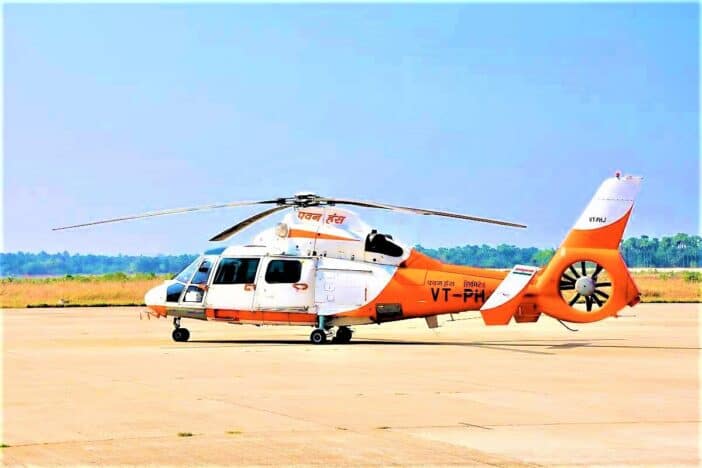
The fastest way to Great Nicobar isalnds from Port Blair is by air. The only aircraft tourists can travel by is a helicopter since the runway is not long enough for passenger airplanes to land. Helicopters fly to and from Great Nicobar twice or thrice a week. You take a helicopter from Port Blair to Car Nicobar and from Car Nicobar to Campbell Bay. The Helicopter Schedule offers a better understanding of the route.
The helicopter rates vary for islanders, Indian non-islanders, and foreign nationals. The cost per ticket for Indian nationals who are not from the islands (referred to as mainlanders or non-islanders) of Andaman and Nicobar is INR 13400. However, every island on the way from Port Blair to Great Nicobar Island has a specific quota and it is therefore difficult for tourists to find a seat on the helicopter.
For foreign nationals, it is necessary to inquire at the counter about the exact cost of the ticket. Apply for tickets the morning before your travel date at the Secretariat gate and the list of selected passengers will be put up the same evening. Remember, the office remains closed on Saturdays and Sundays so if you’re travelling on Monday, make sure to get your tickets on Friday.
For further information: Click Here!
- Ferry / Ship
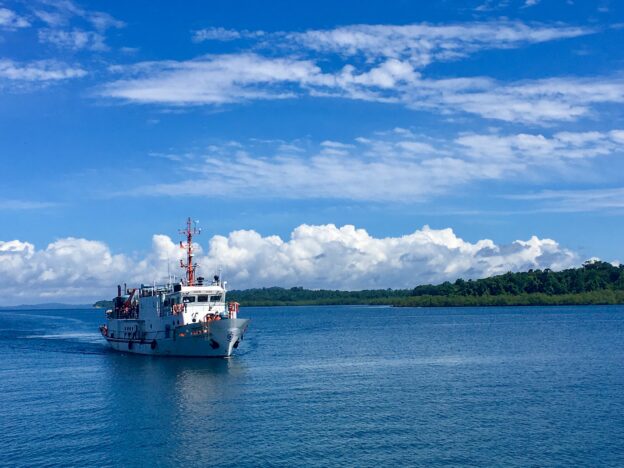
Although a longer route, taking a government ship to Great Nicobar island is a surer way to travel. The easiest way to get your tickets is to visit the Directorate of Shipping Service (DSS) office or book them online by following the government ferry booking procedure. You can login to DSS STARS, their official website and find government ferry availability.
There are a number of ships of different sizes and facilities that are available based on your budget. The average cost for an Indian non-islander is between INR 2400 and INR 3000 for a seat in a first-class cabin. Bunks cost approximately INR 800 – 1200 and deluxe suites, which are the most spacious and comfortable seats – about INR 2800-3200.
Although more reliable than the helicopter, ships that ply between the islands are approximately once in ten days. The journey from Port Blair to Great Nicobar takes 24-32 hours depending on the weather. The frequency depends most often on the weather; the stormier and rainier the weather, the less frequent they become.
For further information, you can contact the DSS at the following numbers: Contact number: (03192) 232528 / 232742.
Read More: Best Time to Visit Port Blair


Tribes of Great Nicobar
The population of Great Nicobar is largely comprised of indigenous people, the tribes of Andaman and Nicobar Islands and settlers – individuals from the mainland whose families settled here well before and around the time of India’s independence.
There are two indigenous Nicobar island tribes – the Shompen and the Nicobarese.
The Shompen tribe is one that does not interact much with the urban settlements of the island. Designated as a Scheduled Tribe of the Andaman and Nicobar Islands, they live in the forest areas of the island and follow a hunter-gatherer way of living. They engage in barter with different communities – both the settlers and the Nicobarese.
The Nicobarese is a term used to refer to the dominant tribes of the Nicobar Islands. These tribes are divided by island and the central location for this group of tribes is Car Nicobar. Although each tribe has its own language, the Nicobarese are all familiar with the Car Nicobarese language which is descended from the Roman script. Before the tsunami, the Nicobarese followed animism – worshiping animals and natural symbols on which they depended. However, after the tsunami, most of them have converted to Christianity. Some of the others who are still dependent on the forests, still follow animism.
Post-tsunami, lifestyles have changed completely for both the tribes and they have become more urbanized. For the Nicobarese especially, their livelihoods have changed from being forest-dependent to more market-centric.
Both tribes have been relocated and their new houses are made of materials that are different from the natural resources that they used earlier.
Tribal tourism is prohibited and individuals are only allowed to interact with them for research, after seeking prior permission from the Tribal Council.


Travelling to Great Nicobar
How Many Days are Enough for Great Nicobar?
Unlike the Andaman Islands, Nicobar Island tourism is not very developed. It is still in the beginning stages, with a lot of the government’s initiatives focusing on developing facilities for the local citizens after the disastrous effects of the 2004 tsunami before turning their attention to tourism.
When planning a trip to Great Nicobar, it is important to keep in mind the frequency of ships and availability of flights – a factor that is largely influenced by the weather conditions.
Spending about a week to ten days on this slow-paced island would be more than enough to explore and indulge in all that you want.


Where to Stay in Great Nicobar?
Tourists can stay only in Campbell Bay and travel to other parts of the island from here.The accommodation has to be booked in the Panchayat Tourism Guest House at Campbell Bay Great Nicobar island. At the Panchayat Tourism Guest House, the cost per bed per night is INR 400.
Accommodation can be booked prior to travel by calling the concerned guesthouse. It is also a good practice to confirm the cost before traveling.
One can do so by calling the following numbers: Panchayat Tourism Guesthouse: 03193 264267 / +91 9474229928.
For government officials, there is also the option to stay at the APWD (Andaman Public Works Department) Guesthouse. Here, the cost for a standard non-AC room is INR 500 and INR 800 for a standard AC room.
Bookings can be made on +91 9042136577 / 03193 264264.


Top things to do in Great Nicobar
- Visit the Campbell Bay National Park in Great Nicobar Biosphere Reserve
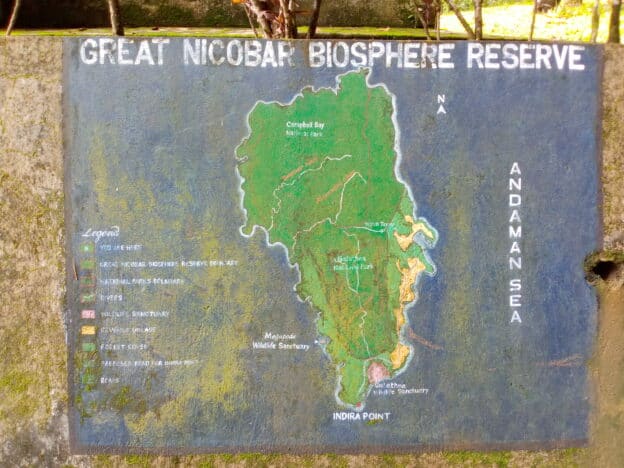
In 2013, the Great Nicobar Biosphere (GNBR) was declared a Man and Biosphere Reserve by the United Nations Educational, Social, and Cultural Organisation (UNESCO) in order to foster sustainable development with the assistance of the local communities.
Great Nicobar itself forms as a part of the Indo-Burma biodiversity hotspot and the reserve covers over 85% of the island. This reserve is home to several endemic species that are found only in the Nicobar Islands including the Nicobar megapode, the edible-nest swiftlet, the Nicobar long-tailed macaque, Nicobar tree shrew, and the famous Coconut Crab!
Within the Biosphere Reserve are two designated national parks – the Campbell Bay National Park and the Galathea National Park. Individuals and groups can go on a nature trail hike, which takes approximately three hours and get a chance to see several bird species. Guides can be arranged via the Forest Department in advance.
- Visit the Galathea National Park in Great Nicobar Biosphere Reserve
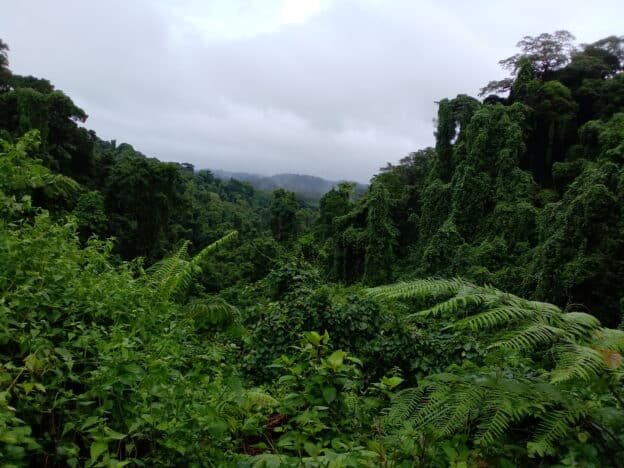
Separated by the Campbell Bay National Park by 12 km forests, Galathea National Park is a part of the tropical and sub-tropical forests of the Great Nicobar Biosphere Reserve. In addition to the species mentioned earlier, the Nicobar Pigeon, an endemic species, is also found here and draws birders from around the country. Other species that can be seen include the Giant Leatherback Sea Turtle, Malayan Box Turtle, and Saltwater Crocodile that started coming to the island only after the tsunami.
- Relax on Beaches or Swim in the Seas of Great Nicobar
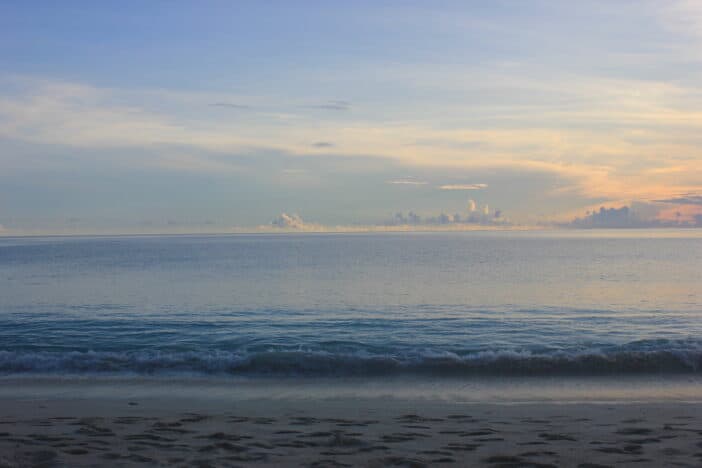
There are several beaches that can be visited on the island however only one is suitable for safe swimming. This can be found out after arriving in Great Nicobar island. This beach also permits snorkeling but personal equipment must be carried from the mainland or Port Blair as there are no rental shops available.
- Go Birdwatching
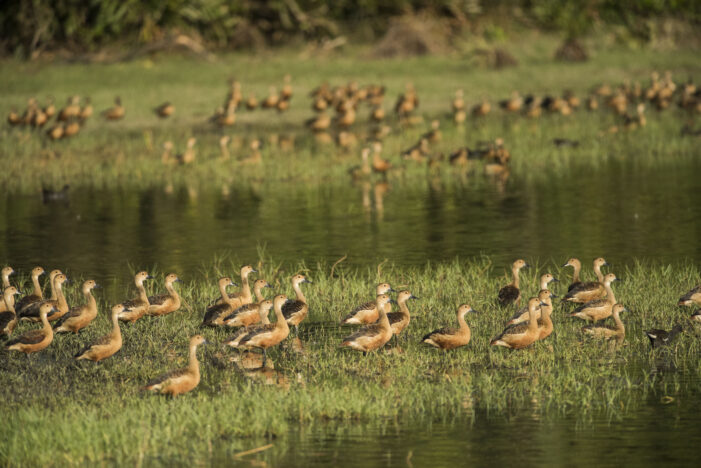
In addition to the birds seen in the Great Nicobar Biosphere Reserve, Campbell Bay National Park and Galathea National Park, the general areas of Campbell Bay and surrounding places support large numbers of different bird species, ranging from waders to raptors.


When is the Best Time to Visit Great Nicobar?
Like most tropical areas, Great Nicobar receives heavy rainfall throughout the year especially in monsoon season. The months with the least rainfall (December to April) are ideal to enjoy the best weather and outdoor activities.


Getting Around Great Nicobar
Great Nicobar is divided into multiple smaller towns, with Campbell Bay as its main area of activity. There are two main roads – North-South Road and East-West Road – that connect the entire island. Within Campbell Bay Great Nicobar island, one can travel using local auto-rickshaws.
To go from one part of the island to another, there are local government buses that ply regularly from Campbell Bay (0km) to Shastri Nagar (35km), with stops at each town in-between. If you hold a two-wheeler license, it is also possible for you to hire one with or without gear to help you move around during your stay. In addition, four-wheelers can also be hired but are quite expensive. In most cases, cars are required only to go to Galathea National Park or the Great Nicobar Biosphere Reserve to where buses do not directly ply.
However, the town of Campbell Bay is small enough to be covered by a walk. So if you love going on long walks or simply want a breath of fresh air, put on your walking shoes and get going!


Where to Eat in Great Nicobar?
Meals can be eaten at the Tourism Guesthouse or at Suruchi Restaurant. There are also local eateries as well as a few chaat places at the Jetty Market and Zero Market. One of the most frequented eateries is the one run by Mr. Simachalam right opposite the Tourist Guesthouse.
The average cost per meal at any of the eateries is INR 150. Chaat varies from INR 10 to INR 50.


Nightlife in Great Nicobar
- Owling – If you enjoy birdwatching in any capacity, the Nicobar Scops Owl is a true treat for the eyes. This small owl is endemic to the Nicobars and can be spotted in several places in and near Campbell Bay. The only other owl found on Great Nicobar is the Brown Hawk Owl, also known as the Brown Boobook.
While there are no bird guides on the island, it is fairly easy to check where these owls can be spotted and what times they are usually seen by using citizen science databases like eBird.
- Natural night lights – A rare sight anywhere in the world, the beaches of Great Nicobar light up at night, in the literal sense of the word! Bioluminescent phytoplankton that reside in the sea often light up the shore when waves crash after nightfall. The woods surrounding some of the beaches are also inhabited by fireflies that light up trees like Christmas lights.


Important Information about Great Nicobar Island
- Travelling and tickets: The infrequency of the ships plying to and from Great Nicobar could be a damper on your plans if you do not plan sufficiently ahead of time. Make sure you have a few days’ buffers in place if you intend to fly back to the mainland from Port Blair as soon as you return from Great Nicobar. If you have plans to explore Andaman by visiting Neil Island, Havelock Island, and Ross Island, you might want to give yourself at least 7-10 days before booking your flight tickets.
- Food and Money: Other than one or two shops, none of the eateries or stores accept card payments. There are two ATMs in Campbell Bay Great Nicobar – Co-operative Bank and Syndicate Bank. However, there are no fixed schedules for when money is filled in them. It is, therefore, best for you to carry sufficient cash in hand for the duration of your stay. This holds true for Neil and Havelock as well.
- Internet and Connectivity: BSNL is currently the sole service provider on the island. The connectivity is highly dependent on the weather. Network fluctuations are common and rains and stormy weather will affect the ease with which one can make calls. When it comes to the internet, there are some parts of the island that will allow 2G connections, sufficient to use WhatsApp. However, for browsing or emails, one can visit one of the three internet cafes that are situated in the market areas of Campbell Bay.


G2A Insider Tips
- Choose the right network: The first and most important thing to keep in mind is the network. BSNL is the only service provider that works on the island. In the case that you are from a part of India other than Kolkata, it is best to get the sim card from your city. Residents of Kolkata can also purchase their sim cards from the BSNL head office in Port Blair.
- Carry enough hard cash: Secondly, make sure to withdraw enough money in Port Blair and carry it to Great Nicobar island because there are only two ATMs on the island, and do not get filled at regular times.
- Be prepared for rain: Even in the driest months, there can be sudden bouts of heavy rain. Make sure to carry sufficient rain clothes and appropriate footwear that will protect you from the weather.
- Stay safe from bites: Since Great Nicobar island is a hot and humid area, mosquitoes thrive. It is therefore important to carry sufficient amounts of mosquito repellent or buy some at the local markets. Additionally these are heavy forest areas so insect bites are extremely common. Hence, also wear full clothes when entering the forests.


FAQs
-
How do we interact with the tribals?
The tribal groups mostly keep to themselves, not interacting much with the mainstream populations. Some portions of the Nicobarese live in the urban area and are employed in a variety of government sectors. However, tourists are not allowed to interact with them. In order to interact with tribes who are not assimilated into mainstream society for research purposes, a Tribal Permit needs to be acquired from the Tribal Council.
-
How is the network connectivity?
With BSNL as the only service provider catering to the entirety of the Nicobar Islands population, there are several issues that are often faced. However, within the next year, the network is expected to improve with the laying of a submarine cable connecting Great Nicobar to Chennai.
-
What is the lifestyle like?
The community of Great Nicobar is one that lives in peace and quiet. The people are extremely friendly and helpful, and do not let you feel like a visitor. Every day, shops remain closed from 12pm – 3pm for a lunch break.
-
What language is most common?
The most common language spoken by the entire population is Hindi. Two other languages that are spoken by large populations on the island are Tamil and Bengali.
-
How does one move around on the island?
Within Campbell Bay, which is the main town, it is fairly easy to navigate from one place to another on foot. To reach other parts of the island, one can travel by bus or hire a vehicle.
-
What are the permissions required?
Indian citizens require no prior permissions before coming to Great Nicobar. To visit Great Nicobar Biosphere Reserve and Galathea National Park, visitors have to inform the District Forest Officer at the Forest Department located in Campbell Bay.
Popular Tourist Islands
About Andaman Islands
Popular Places to Visit
Customer Happiness
Secure Payments
No Hidden Costs
Fast Confirmations
Stay updated with all the excitement that Andamans has to offer

If you have a flair for writing, write for us and get featured.
Get lost or never. You decide. Download our handy tour guides to plan your trip.